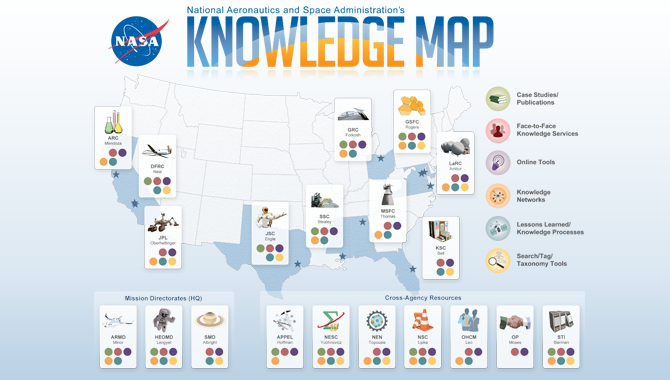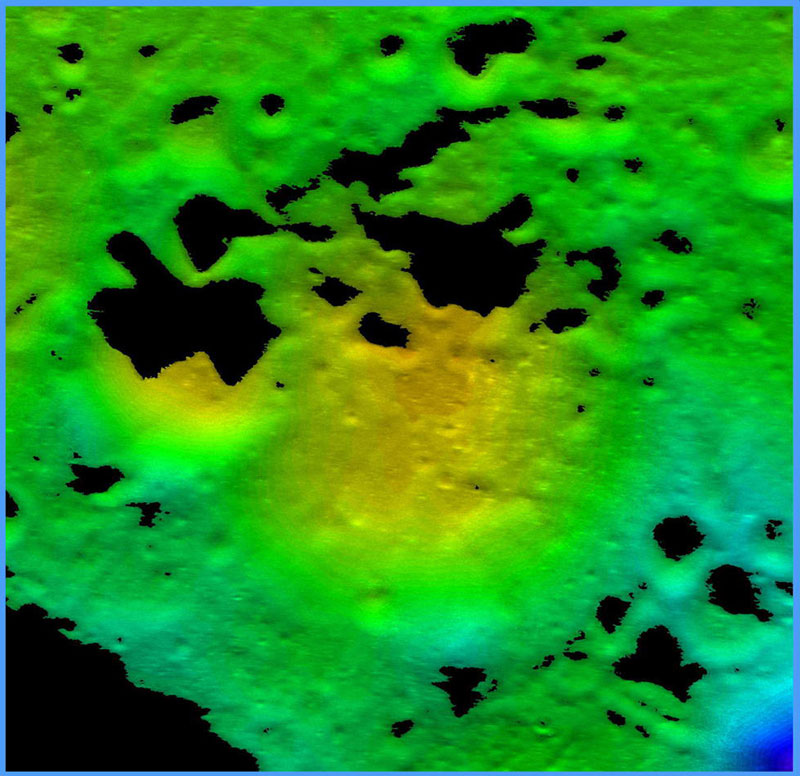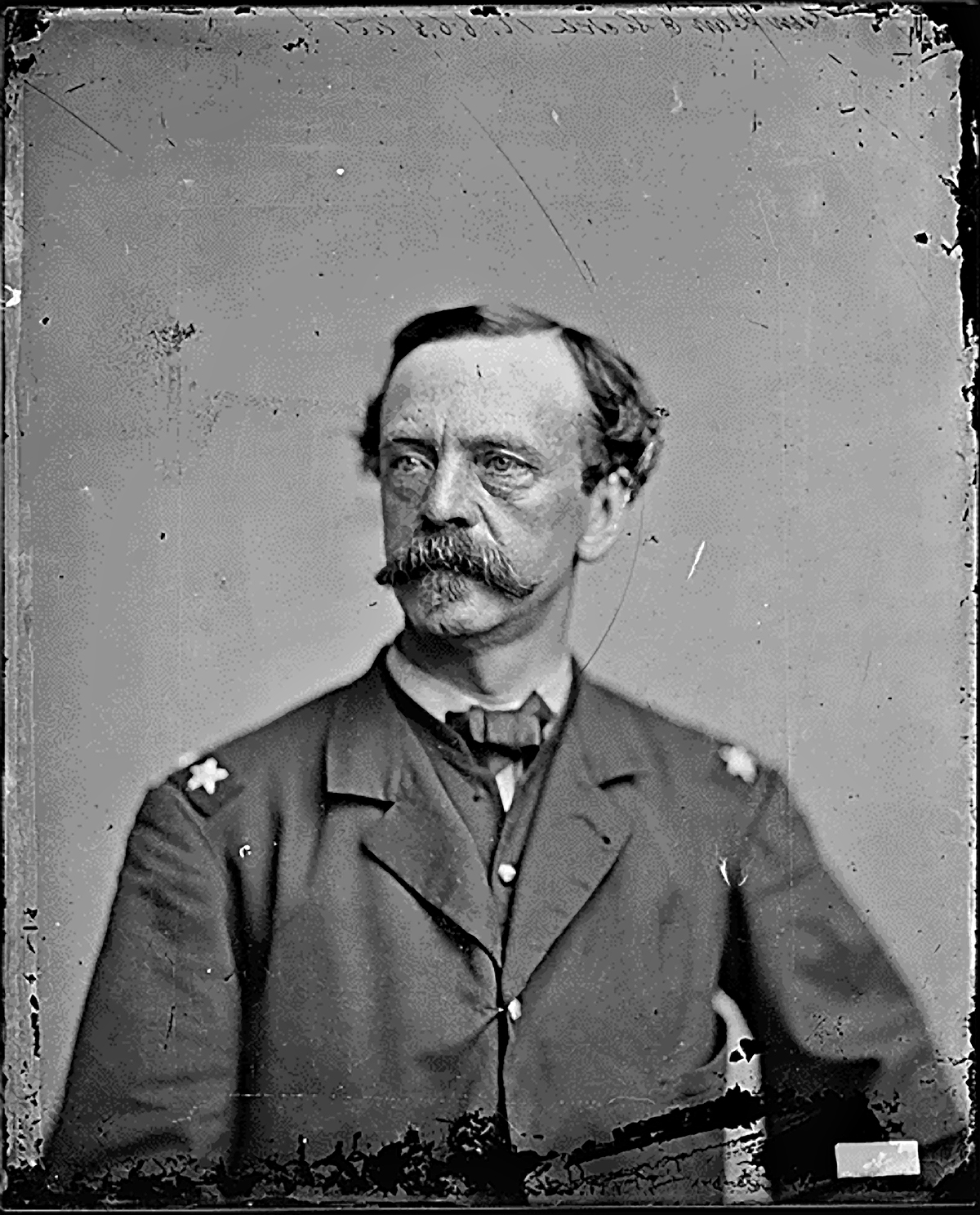
By Matthew Kohut and Haley Stephenson
Need to understand something about engine cutoff sensors, the physiological impact of extended stays in low-Earth orbit, or how to drive a rover on Mars? That kind of specialized expertise exists at NASA, and often nowhere else. But where does that unique know-how live? How and where is it captured and shared? NASA’s interactive knowledge map serves as a springboard for helping practitioners find what they don’t know and share what they do.
To paraphrase science-fiction writer William Gibson, NASA’s knowledge is not evenly distributed. Sometimes the people who know something and the people who need to know it don’t connect. NASA’s missions continue to increase in complexity, teams become more distributed, and technology advances. At the same time, Apollo and shuttle generations are disappearing. All these factors make knowledge-sharing connections critical to organizational success.
While learning from its successes and failures is at the core of NASA’s work, its track record for doing so is also unevenly distributed; the agency has done better in some instances than others.
Developing a more consistent knowledge capability across the agency was part of what motivated the Aerospace Safety Advisory Panel, a Congressionally established advisory group, to recommend that NASA “establish a single focal point (a chief knowledge officer) within the agency to develop the policy and requirements necessary to integrate knowledge capture across programs, projects, and centers.”
In response, newly appointed NASA Chief Knowledge Officer Ed Hoffman convened the first meeting of NASA’s knowledge community—individuals identified by center directors and mission directorate associate administrators as chief knowledge officers or points of contact—in January 2012. Their discussions revealed an abundance of knowledge work happening across NASA’s centers, mission directorates, and cross-agency organizations: forums, lunches, case studies, databases, online expert-locator systems, and more. Some activities were well established and well known, while others were just getting started.
This big picture was an eye-opener. The knowledge community decided to develop a comprehensive index of the services available across the agency. And so began their initiative to create an interactive map—a knowledge map—that made NASA’s knowledge services findable to all.
It Started with a Spreadsheet
After the inaugural meeting, Mike Lipka, the knowledge point of contact for NASA’s Safety Center, took the initiative to document the services community members had described at the initial meeting. He organized what he’d captured in a simple matrix that paired each NASA organization with the knowledge services provided, using an ad hoc taxonomy to categorize those services by type (for example, online portals versus publications).
Lipka’s initial exercise laid the groundwork for a more systematic data-gathering effort to create a dynamic, online tool for visualizing and engaging with NASA’s knowledge resources and services.
Each knowledge organization subsequently participated in in-depth interviews about the work within their organizations over the next several months. The resulting data set was impressive and large. The community needed a structured way to communicate about the great work going on across the agency.
A Vocabulary for Knowledge at NASA
Unsurprisingly, the knowledge services described by the chief knowledge officers and knowledge points of contact in their interviews took many forms. Some activities were “self-service,” such as typing a query into a search box or watching a video. These services work well for explicit knowledge that doesn’t require a lot of context or personal judgment. For instance, the fundamentals of earned value management can be codified, broken down, and expressed as a series of concepts without requiring a world-class subject-matter expert.
At the other end of the spectrum, some activities emphasized tacit knowledge, which is dependent on context and personal judgment. This kind of sharing usually requires social interaction. A master practitioner’s knowledge about how to interpret ambiguous test data or make a go or no-go launch decision cannot be transferred through a Google search. Though technology can helpfully extend the reach of a personal story, it doesn’t provide the full experience of face-to-face communication or hands-on learning.
The community agreed upon a set of categories to describe the range of knowledge activities taking place across NASA.
Online Tools. Any online knowledge tools, including but not limited to portals, document repositories, collaboration and sharing sites, and video libraries.
Search/Tag/Taxonomy Tools. Dedicated search engine for knowledge (e.g., Google Search Appliance) and any initiatives related to meta-tagging or taxonomy.
Case Studies/Publications. Original documents or multimedia case studies that capture project stories and associated lessons learned or best practices.
Lessons Learned/Knowledge Processes. Any defined process that an organization uses to identify or capture knowledge, lessons learned, or best practices, including the Lessons Learned Information System vetting process, organization-specific lessons-learned processes, benchmarking, use cases, knowledge-sharing recognition programs, knowledge product validation processes, and communications about expectations related to knowledge sharing.
Knowledge Networks. Any defined knowledge network, such as a community of practice, expert locator, mass collaboration activity, or workspace specifically designed to enable exchanges and collaboration.
Social Exchanges. Any activities that bring people together in person to share knowledge (e.g., forums, workshops, Lunch and Learn/Pause and Learn). The reach of these activities can be multiplied through online tools such as videos and virtual dialogues.
The categories are not the only ones that could have been created, and they are not a perfect fit for every knowledge activity at NASA, but they provide a means for making useful distinctions among different activities. The knowledge community decided to adopt these categories in January 2013, agreeing that this terminology could be improved in the future.
This vocabulary provided the knowledge community with a foundation for talking about their services, tools, and activities with each other, the practitioners they serve, and the agency’s stakeholders. For instance, online tools such as the Jet Propulsion Laboratory’s Wired wiki or Marshall Space Flight Center’s ExplorNet satisfy different knowledge needs than the lessons learned and knowledge processes at Goddard Space Flight Center or the Human Exploration Operations Mission Directorate. The community wanted to do more than just talk about these services, however—they wanted to see them.
Visualizing Knowledge at NASA
Seeing is believing, and visualizing a knowledge landscape can promote increased sharing.
The data the knowledge community aggregated serves as a starting point: what is happening, who is doing it, and how can others access it? The community recognized that their data would change and grow over time. Creating a visualization that could accommodate that evolution meant thinking beyond what the word “map” usually brings to mind: subways, floor plans, theme parks, and possible buried treasure.
Instead, the map needed to be a kind of Rubik’s cube, allowing the data to be sliced in multiple ways as the data set became richer and larger. This interactivity would allow users to browse the community’s data set as it currently existed—by knowledge category, center or organization, and knowledge point of contact—and as it could exist in the future—by discipline, topic, accessibility, or any other variable.
Just as the community wanted its data openly displayed on the map, it also wanted the map itself to be broadly accessible online. This meant the map needed to be “platform independent”: it shouldn’t matter if a user had an iPhone or an Android tablet. Their access to the data and experience with the map should be the same. To satisfy this requirement, the map development team decided to build the map using HTML5, a coding language that achieved the vision of making the map accessible across all platforms. If you have an Internet connection and a browser, you can browse the current map of NASA’s knowledge services at km.nasa.gov/knowledge-map.
Where the Map Leads Next
The NASA knowledge map represents a step forward in NASA’s evolution as a learning organization. It is the first online tool of its kind that aggregates the knowledge work happening across NASA, making it a springboard for NASA practitioners and stakeholders to access resources to find answers and solve problems.
It demonstrates a commitment and dedication to greater transparency about the knowledge services available across the agency. While some resources remain protected behind firewalls, the community has identified the services available within each organization and provided points of contact.
The map does not resolve the challenge of making knowledge universally accessible across organizational lines, but it is a step toward building more resilience into NASA’s knowledge infrastructure. There’s plenty left to do. Half the NASA workforce is eligible for retirement and could walk out the door with critical knowledge that has not yet been passed on to others. Young professionals at the other end of the career path have had fewer opportunities than previous generations at NASA to get hands-on experience.
In short, the 2013 NASA knowledge map is a beginning, not an ending. It will continue to grow as other organizations within NASA share their knowledge resources and as the knowledge needs of NASA practitioners evolve.
Related Links
- NASA’s Knowledge Map
More Articles by Matthew Kohut
- An Argentine Partnership with NASA (ASK 46)
- Interview with Bryan O’Connor (ASK 45)
- FAST Learning (ASK 43)
- Lessons from the National Ignition Facility (ASK 41)
- Interview with Wayne Hale (ASK 40)
More Articles by Haley Stephenson
- The Hitchhiker’s Guide to Software Engineering at NASA (ASK 50)
- The Toothbrush Hack (ASK 49)
- Something to Shout About: Bloodhound Supersonic Car (ASK 45)
- Weathering Ike (ASK 44)
- Factoring in Humans (ASK 41)









